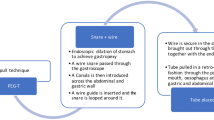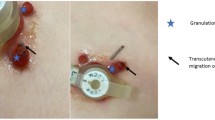Abstract
Background
There are few published data on non-endoscopic removal of percutaneous endoscopic gastrostomy devices in children.
Aims
To describe prospective data acquired for traction removal of percutaneous endoscopic gastrostomy devices at a single pediatric center over a 5-year period.
Methods
Data were obtained from endoscopy records, computerized hospital patient information systems and case note analysis. The device that could be removed by traction was the Corflo (Merck) 12-Fr percutaneous endoscopic gastrostomy tube with a collapsible internal retention dome. All procedures were performed under general anesthesia.
Results
Between 2002–2006, 220 children underwent percutaneous endoscopic gastrostomy removals (166 by traction, 51 endoscopically and 3 Foley catheter to button conversions). The median duration between percutaneous endoscopic gastrostomy insertion and low profile button device substitution was 0.83 years (0.12–3.86). Complications from traction removal included internal retention dome separation in two cases (allowed to pass per rectum, uneventfully), failure to a insert a low profile button device needing percutaneous endoscopic gastrostomy reinsertion, enterocutaneous fistula requiring surgical closure in one patient and laparoscopy for suspected low profile button device misplacement in one instance. The material cost of endoscope disinfection (£10) and disposable usage (£80) avoided by traction removal was calculated at £90 per procedure.
Conclusion
No mortality occurred as a result of the traction removal of percutaneous endoscopic gastrostomy tubes. Laparoscopy for suspected low profile button device misplacement was needed in one case (0.60%). Traction removal of percutaneous endoscopic gastrostomy tubes was generally safe and a cost-saving procedure in our experience.
Similar content being viewed by others
References
Craig GM, Carr LJ, Cass H, et al. Medical, surgical, and health outcomes of gastrostomy feeding. Dev Med Child Neurol. 2006;48(5):353–360.
Sullivan PB, Juszczak E, Bachlet AM, et al. Gastrostomy tube feeding in children with cerebral palsy: a prospective, longitudinal study. Dev Med Child Neurol. 2005;47(2):77–85.
Avitsland TL, Kristensen C, Emblem R, et al. Percutaneous endoscopic gastrostomy in children: a safe technique with major symptom relief and high parental satisfaction. J Pediatr Gastroenterol Nutr. 2006;43(5):624–628.
Sullivan PB, Juszczak E, Bachlet AM, et al. Impact of gastrostomy tube feeding on the quality of life of carers of children with cerebral palsy. Dev Med Child Neurol. 2004;46(12):796–800.
Gauderer MW, Ponsky JL, Izant RJ Jr. Gastrostomy without laparotomy: a percutaneous endoscopic technique. J Pediatr Surg. 1980;15(6):872–875.
Palmer GM, Frawley GP, Heine RG, Oliver MR. Complications associated with endoscopic removal of percutaneous endoscopic gastrostomy (PEG) tubes in children. J Pediatr Gastroenterol Nutr. 2006;42(4):443–445.
Yaseen M, Steele MI, Grunow JE. Nonendoscopic removal of percutaneous endoscopic gastrostomy tubes: morbidity and mortality in children. Gastrointest Endosc. 1996;44(3):235–238.
Mollitt DL, Dokler ML, Evans JS, Jeiven SD, George DE. Complications of retained internal bolster after pediatric percutaneous endoscopic gastrostomy. J Pediatr Surg. 1998;33(2):271–273.
Giuliani S, Betalli P, Midrio P, et al. Percutaneous endoscopic gastrostomy tubes (PEG) in children: a rare complication. J Pediatr Gastroenterol Nutr. 2004;39(Supplement 1):S338.
Kobak GE, McClenathan DT, Schurman SJ. Complications of removing percutaneous endoscopic gastrostomy tubes in children. Pediatr Gastroenterol Nutr. 2000;30(4):404–407.
El-Rifai N, Michaud L, Mention K, et al. Persistence of gastrocutaneous fistula after removal of gastrostomy tubes in children: prevalence and associated factors. Endoscopy. 2004;36(8):700–704.
Siegel TR, Douglass M. Perforation of an ileostomy by a retained percutaneous endoscopic gastrostomy (PEG) tube bumper. Surg Endosc. 2004;18(2):348.
Lattuneddu A, Morgagni P, Benati G, Delvecchio S, Garcea D. Small bowel perforation after incomplete removal of percutaneous endoscopic gastrostomy catheter. Surg Endosc. 2003;17(12):2028–2031.
Author information
Authors and Affiliations
Corresponding author
Rights and permissions
About this article
Cite this article
Srinivasan, R., Irvine, T. & Dalzell, A.M. Traction Removal of Percutaneous Endoscopic Gastrostomy Devices in Children. Dig Dis Sci 55, 2874–2877 (2010). https://doi.org/10.1007/s10620-009-1090-z
Received:
Accepted:
Published:
Issue Date:
DOI: https://doi.org/10.1007/s10620-009-1090-z




